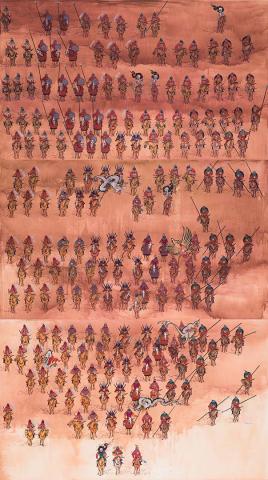Contemporary Mongol zurag
By Reuben Keehan
APT8 October 2015
Baatarzorig Batjargal, Nomin Bold, Uuriintuya Dagvasambuu and Gerelkhuu Ganbold are exemplars of contemporary Mongol zurag, a critical revival of a painterly idiom developed during the Mongolian independence movement of the early twentieth century. Characterised by its ultra-fine brushwork, bright colours, flattened perspective and themes drawn from everyday life, Mongol zurag (literally ‘Mongolian painting’) synthesised elements of Tibetan Buddhist tangka painting, Chinese guohua and the Khitan equestrian art of the Liao Dynasty (907–1125). It emerged to express themes of secular nationalism at the time of Mongolia’s declaration of independence from the Manchu Qing empire during China’s Xinhua Revolution of 1911, and its highly detailed, all-over composition is typified by Balduugiin Sharav’s classic One Day in Mongolia 1911. As Mongolia came under Soviet influence, it was eventually subsumed into the officially mandated socialist realist style that would dominate Mongolian culture from the bloody Stalinist purges of 1930s until the Democratic Revolution of 1990. Established as a subject at the Mongolian University of Arts and Culture as Mongolia sought to reconstitute its national identity in the late 1990s, Mongol zurag has been taken up by a passionate new generation of artists who find within it the means of addressing the contradictions of their lives at a time of unprecedented urbanisation, financial precariousness and competing cultural influences.
Feature image: Nomin Bold's Labyrinth game 2012 and Tomorrow 2014, installed at GOMA for the 8th Asia Pacific Triennial of Contemporary Art, April 2016 / Collection: QAGOMA / © Nomin Bold / Photograph: M Sherwood, QAGOMA
Connected objects

Tumbash model XQ 2014
- DAGVASAMBUU, Uuriintuya - Creator

Unnamed energy 2014
- DAGVASAMBUU, Uuriintuya - Creator

Path to wealth 2013
- DAGVASAMBUU, Uuriintuya - Creator

Tomorrow 2014
- BOLD, Nomin - Creator

Labyrinth game 2012
- BOLD, Nomin - Creator

Nomads 2014
- BATJARGAL, Baatarzorig - Creator
Related artists
BATJARGAL, Baatarzorig
1983
- present
Full profile
for BATJARGAL, Baatarzorig
BOLD, Nomin
1982
- present
Full profile
for BOLD, Nomin
DAGVASAMBUU, Uuriintuya
1979
- present
Full profile
for DAGVASAMBUU, Uuriintuya
GANBOLD, Gerelkhuu
1988
- present
Full profile
for GANBOLD, Gerelkhuu
Metadata, copyright and sharing information
About this story
- Subject
